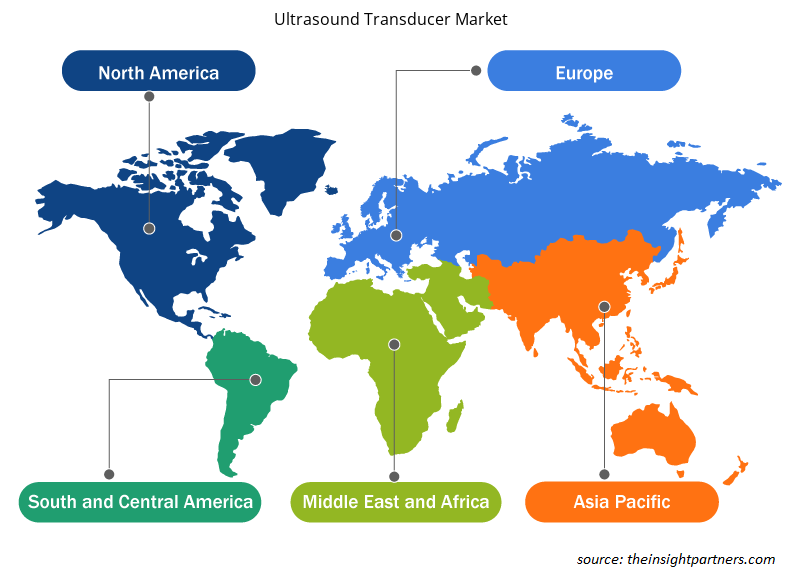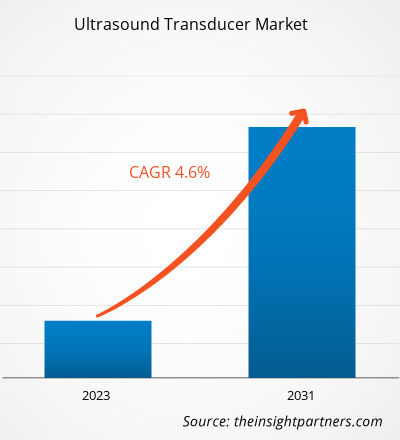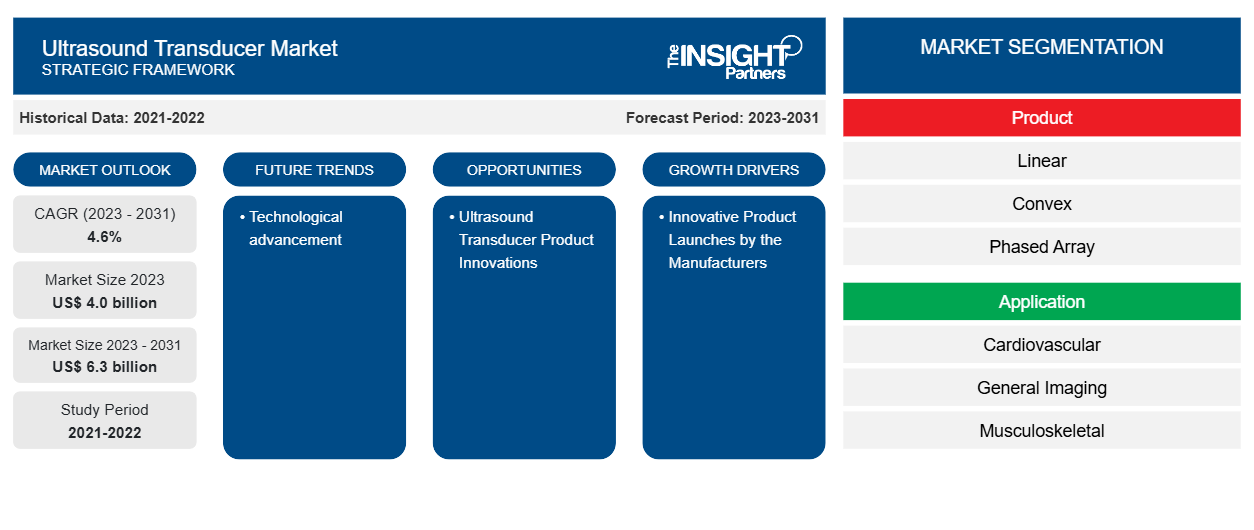Le marché des transducteurs à ultrasons était évalué à 4,0 milliards de dollars américains en 2023 et devrait atteindre 6,3 milliards de dollars américains d'ici 2031. Le marché devrait enregistrer un TCAC de 4,6 % entre 2023 et 2031. Les progrès dans la conception de produits dans l'industrie du diagnostic devraient rester les principales tendances du marché des transducteurs à ultrasons.
Analyse du marché des transducteurs à ultrasons
Lancements de produits innovants par les fabricants
Le lancement de nouveaux produits par les fabricants est l'un des facteurs influents responsables de la croissance du marché des transducteurs à ultrasons. En avril 2024, Royal Philips a reçu l'approbation de la FDA américaine pour son « transducteur TEE ». Le produit nouvellement lancé est conçu pour offrir aux patients un confort global amélioré pour le diagnostic précoce des maladies cardiaques structurelles dirigées par Philips : le transducteur à ultrasons pour échocardiographie transoesophagienne (TEE). Par conséquent, la TEE aide les cardiologues à fournir des images très détaillées du cœur et de sa structure interne avec une imagerie TEE 3D de qualité de sortie.
En août 2023, Verasonics, Inc. a annoncé le lancement d'un nouveau produit, le « Vantage Research Ultrasound System », en introduisant de nouveaux transducteurs, dont un réseau de lignes et de colonnes de 15 MHz et trois transducteurs d'imagerie générale. Le produit nouvellement lancé est une approche rentable de la capture à haute fréquence d'images pour les applications d'imagerie volumique 3D et élimine le nombre élevé de canaux ou l'exigence de multiplexage des réseaux matriciels.
En janvier 2023, FUJIFILM Sonosite, Inc. a annoncé le lancement d'un nouveau produit, le « Sonosite PX Ultrasound System ». Le Sonosite PX est la nouvelle génération de Sonosite POCUS avec une clarté d'image avancée, des fonctionnalités d'efficacité du flux de travail et un format adaptable. De plus, le Sonosite PX s'appuie sur des normes légendaires de durabilité, de fiabilité et de facilité d'utilisation sur lesquelles les cliniciens du monde entier comptent avec ce nouveau système d'échographie.
Aperçu du marché des transducteurs à ultrasons
La technologie, l’innovation et les solutions intelligentes continuent d’influencer considérablement les transducteurs à ultrasons. Les lancements de produits innovants par les fabricants et l’adoption croissante des transducteurs à ultrasons au point de service (POC) sont les facteurs les plus influents responsables de la croissance du marché des transducteurs à ultrasons. L’innovation dans la conception des produits et l’introduction d’appareils à ultrasons miniaturisés et portables sont des tendances clés pour la croissance du marché des transducteurs à ultrasons. Les innovations de produits de transducteurs à ultrasons offriront des opportunités de marché lucratives pour la croissance du marché.
Personnalisez ce rapport en fonction de vos besoins
Vous bénéficierez d'une personnalisation gratuite de n'importe quel rapport, y compris de certaines parties de ce rapport, d'une analyse au niveau des pays, d'un pack de données Excel, ainsi que d'offres et de remises exceptionnelles pour les start-ups et les universités.
-
Obtenez les principales tendances clés du marché de ce rapport.Cet échantillon GRATUIT comprendra une analyse de données, allant des tendances du marché aux estimations et prévisions.
Moteurs et opportunités du marché des transducteurs à ultrasons
Introduction de transducteurs à ultrasons au point de service (POC) pour favoriser le marché
L'échographie au point de service (POC) est un outil de diagnostic polyvalent qui permet aux cliniciens d'intégrer l'imagerie échographique directement pour l'évaluation et l'intervention des patients, quels que soient les contextes de soins de santé, y compris au chevet du patient ou pendant le transport du patient. Par conséquent, l'échographie au point de service peut améliorer l'efficacité du traitement médical et améliorer les résultats des patients en réduisant finalement les coûts des soins de santé. L'échographie continuant de devenir la modalité d'imagerie de choix pour de nombreux cliniciens, il existe une forte demande d'appareils à ultrasons portables. Une sonde à ultrasons portative est un exemple de POCUS qui gagne en popularité en raison de sa facilité d'utilisation et de sa capacité à capturer rapidement des images au point de service. De plus, la demande est élevée pour les POCUS portables en raison de leur taille compacte et de petite taille, qui peuvent se glisser dans les poches des cliniciens et être utilisés pratiquement n'importe où pour capturer les images de diagnostic des patients. De plus, par rapport aux grandes machines à ultrasons standard, le POCUS portable offre aux cliniciens une option beaucoup moins chère avec une imagerie en temps réel et de qualité , ce qui est crucial du point de vue du diagnostic. Par conséquent, le transducteur à ultrasons au point de service contribuera de manière significative dans les années à venir.
Innovations en matière de transducteurs à ultrasons – Une opportunité
La prestation de soins de santé se développe rapidement et les fabricants ont fait des efforts considérables dans le passé pour accélérer la vitesse et la précision des tests de diagnostic dans les milieux de soins de santé pour les transducteurs à ultrasons. Le transducteur à ultrasons sans fil Siemens développé par Siemens Healthineers en est un exemple. Le transducteur à ultrasons sans fil offre un nouveau niveau d'efficacité, de confort pour le médecin et de sécurité pour le patient, avec une radio sans fil à bande ultra-large (UWB) exclusive pour garantir que les images sont transférées à grande vitesse, ont une intégrité totale des données et sont exemptes d'interférences avec d'autres équipements médicaux (câbles câblés). De telles innovations révolutionnaires pour les transducteurs à ultrasons par les fabricants aident les cliniciens à accéder à l'imagerie en temps réel, à un processus ininterrompu et sans tracas pour le patient. Par conséquent, l'innovation de produits innovants offrira des opportunités de marché lucratives et représentera une part de marché considérable dans les années à venir pour le marché des transducteurs à ultrasons.
Analyse de segmentation du rapport sur le marché des transducteurs à ultrasons
Les segments clés qui ont contribué à l’élaboration de l’analyse du marché des transducteurs à ultrasons sont la candidature et les services.
- En fonction du produit, le marché des transducteurs à ultrasons est divisé en sondes linéaires, convexes, à réseau phasé, endocavitrie, Doppler CW, TEE et autres. Le segment des transducteurs à ultrasons convexes pourrait détenir une part de marché plus importante en 2023.
- En fonction des applications, le marché est segmenté en imagerie cardiovasculaire, imagerie générale, musculo-squelettique, obstétrique et gynécologie, vasculaire et autres. Le segment de l'imagerie générale pourrait détenir la plus grande part du marché en 2023.
- En termes d'utilisateur final, le marché est segmenté en hôpitaux, cliniques, centres de diagnostic et centres de chirurgie ambulatoire. Le segment des hôpitaux pourrait détenir la plus grande part du marché en 2023.
Analyse des parts de marché des transducteurs à ultrasons par géographie
La portée géographique du rapport sur le marché des transducteurs à ultrasons est principalement divisée en cinq régions : Amérique du Nord, Asie-Pacifique, Europe, Moyen-Orient et Afrique, et Amérique du Sud/Amérique du Sud et centrale.
L'Amérique du Nord domine le marché des transducteurs à ultrasons. En Amérique du Nord, les États-Unis représentent une part considérable du marché des transducteurs à ultrasons. La présence des principales sociétés de dispositifs médicaux aux États-Unis, les innovations de produits et les produits technologiquement avancés sont les facteurs les plus influents responsables de la croissance du marché. L'Asie-Pacifique devrait connaître le TCAC le plus élevé dans les années à venir.
Aperçu régional du marché des transducteurs à ultrasons
Les tendances régionales et les facteurs influençant le marché des transducteurs à ultrasons tout au long de la période de prévision ont été expliqués en détail par les analystes d’Insight Partners. Cette section traite également des segments et de la géographie du marché des transducteurs à ultrasons en Amérique du Nord, en Europe, en Asie-Pacifique, au Moyen-Orient et en Afrique, ainsi qu’en Amérique du Sud et en Amérique centrale.

- Obtenez les données régionales spécifiques au marché des transducteurs à ultrasons
Portée du rapport sur le marché des transducteurs à ultrasons
| Attribut de rapport | Détails |
|---|---|
| Taille du marché en 2023 | 4,0 milliards de dollars américains |
| Taille du marché d'ici 2031 | 6,3 milliards de dollars américains |
| Taux de croissance annuel composé mondial (2023-2031) | 4,6% |
| Données historiques | 2021-2022 |
| Période de prévision | 2023-2031 |
| Segments couverts |
Par produit
|
| Régions et pays couverts |
Amérique du Nord
|
| Leaders du marché et profils d'entreprises clés |
|
Densité des acteurs du marché des transducteurs à ultrasons : comprendre son impact sur la dynamique commerciale
Le marché des transducteurs à ultrasons connaît une croissance rapide, tirée par la demande croissante des utilisateurs finaux en raison de facteurs tels que l'évolution des préférences des consommateurs, les avancées technologiques et une plus grande sensibilisation aux avantages du produit. À mesure que la demande augmente, les entreprises élargissent leurs offres, innovent pour répondre aux besoins des consommateurs et capitalisent sur les tendances émergentes, ce qui alimente davantage la croissance du marché.
La densité des acteurs du marché fait référence à la répartition des entreprises ou des sociétés opérant sur un marché ou un secteur particulier. Elle indique le nombre de concurrents (acteurs du marché) présents sur un marché donné par rapport à sa taille ou à sa valeur marchande totale.
Les principales entreprises opérant sur le marché des transducteurs à ultrasons sont :
- GE Santé
- Royal Philips NV
- Siemens Healthineers
- Samsung
- Shenzhen Mindray Bio-Medical Electronics Co., Ltd.
- Société Fujifilm
Avis de non-responsabilité : les sociétés répertoriées ci-dessus ne sont pas classées dans un ordre particulier.

- Obtenez un aperçu des principaux acteurs du marché des transducteurs à ultrasons
Actualités et développements récents du marché des transducteurs à ultrasons
Le marché des transducteurs à ultrasons est évalué en collectant des données qualitatives et quantitatives après des recherches primaires et secondaires, qui comprennent des publications d'entreprise importantes, des données d'association et des bases de données. Voici une liste des développements sur le marché des transducteurs à ultrasons et des stratégies :
- En novembre 2023, Siemens Healthineers a annoncé le lancement d'un système d'échographie puissant, polyvalent et abordable qui permet un diagnostic et une évaluation rapides dans tous les contextes cliniques : « ACUSON Maple ». ACUSON Maple est conçu pour les cliniciens qui ont besoin d'un système d'échographie performant prenant en charge une large gamme de cas d'utilisation d'échographie, un produit léger, portable et alimenté par batterie, idéal pour les marchés émergents, les petits hôpitaux, les centres ambulatoires, les cabinets privés et les centres de soins d'urgence.
Rapport sur le marché des transducteurs à ultrasons : couverture et livrables
Le rapport « Taille et prévisions du marché des transducteurs à ultrasons (2021-2031) » fournit une analyse détaillée du marché couvrant les domaines ci-dessous :
- Taille du marché et prévisions aux niveaux mondial, régional et national pour tous les segments de marché clés couverts par le périmètre
- Dynamique du marché, comme les facteurs moteurs, les contraintes et les opportunités clés
- Principales tendances futures
- Analyse détaillée des cinq forces de PEST/Porter et SWOT
- Analyse du marché mondial et régional couvrant les principales tendances du marché, les principaux acteurs, les réglementations et les développements récents du marché
- Analyse du paysage industriel et de la concurrence couvrant la concentration du marché, l'analyse de la carte thermique, les principaux acteurs et les développements récents
- Profils d'entreprise détaillés
- Analyse historique (2 ans), année de base, prévision (7 ans) avec TCAC
- Analyse PEST et SWOT
- Taille du marché Valeur / Volume - Mondial, Régional, Pays
- Industrie et paysage concurrentiel
- Ensemble de données Excel
Rapports récents
Témoignages
Raison d'acheter
- Prise de décision éclairée
- Compréhension de la dynamique du marché
- Analyse concurrentielle
- Connaissances clients
- Prévisions de marché
- Atténuation des risques
- Planification stratégique
- Justification des investissements
- Identification des marchés émergents
- Amélioration des stratégies marketing
- Amélioration de l'efficacité opérationnelle
- Alignement sur les tendances réglementaires























 Obtenez un échantillon gratuit pour - Marché des transducteurs à ultrasons
Obtenez un échantillon gratuit pour - Marché des transducteurs à ultrasons